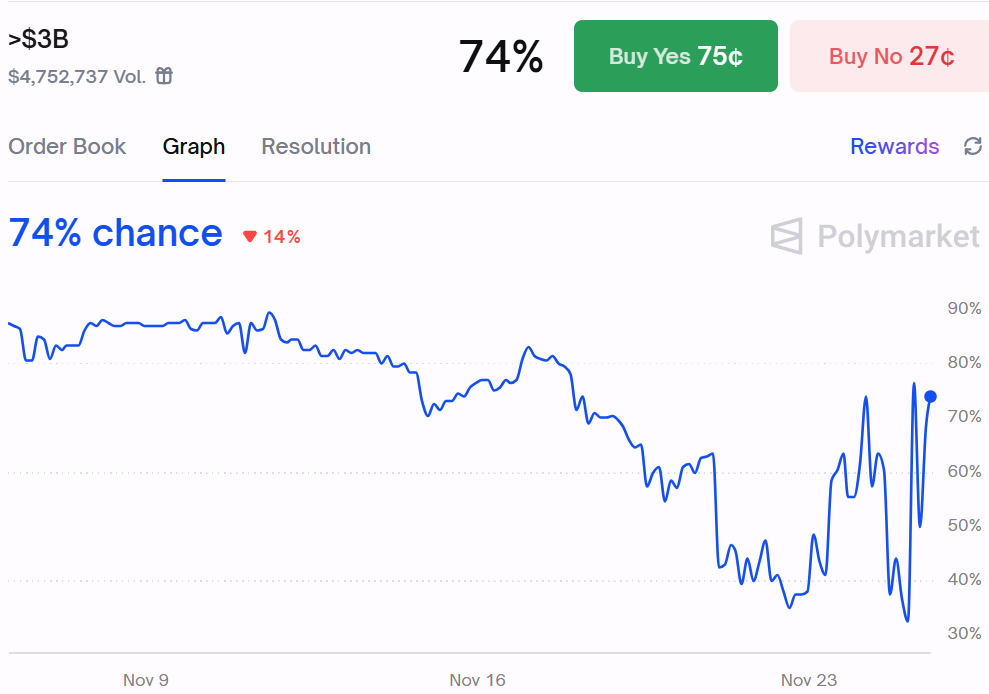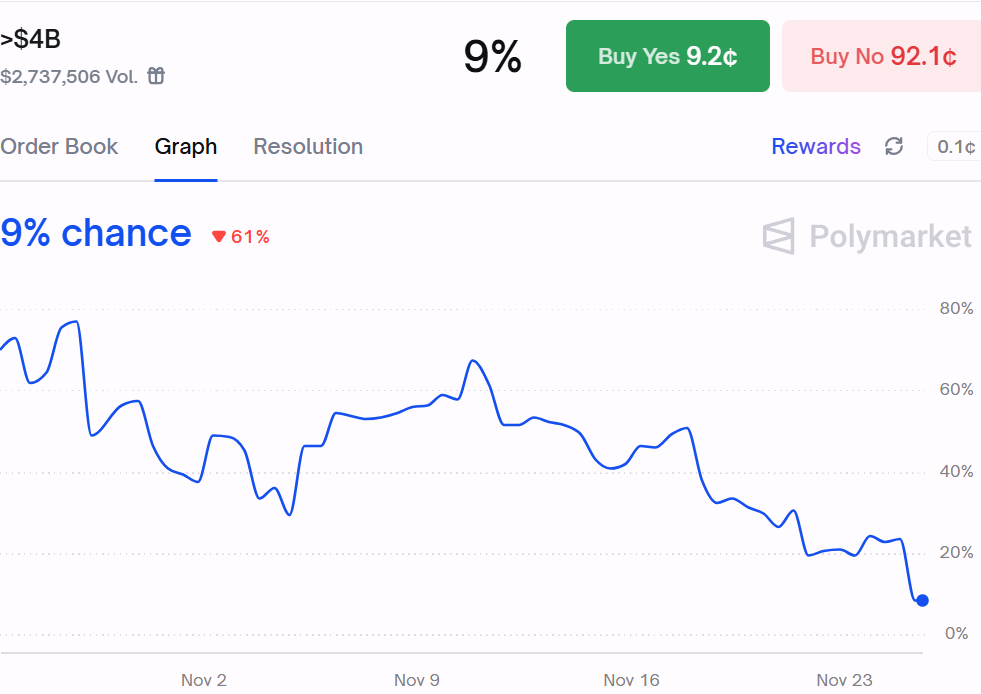Monad’s Debut Shows Why FDV Forecasts Broke as Bitcoin Fell
Monad launched its MON token on Monday with only a small fraction of the total supply in circulation, highlighting a key challenge in crypto valuation: how limited token floats can inflate fully diluted valuations (FDV) that don’t accurately represent true market demand or liquidity.
Monad (MON) went live during one of the year's weakest stretches, with BTC sliding from about $120,000 to below $85,000 in the weeks leading up to the listing.
The market swoon triggered a sharp reversal in Polymarket expectations, as traders treated a multibillion-dollar debut as unlikely. However, many seemed to misunderstand how fully diluted valuation (FDV) works – it's calculated by multiplying the total token supply by the price.
MON's launch is evidence of that, as the token debuted with a $3.2 billion FDV, underscoring how far Polymarket sentiment drifted from the underlying tokenomics. With just over 10.8 billion tokens circulating at launch — or about 10% of the total supply of 100 billion — any price near the sale range was enough to produce a multibillion-dollar valuation.
The market had once entertained the possibility of an $8 billion outcome before flipping deeply bearish, and the debut landed between those extremes.
Monad’s listing underscores a broader tension in this cycle. Low-float launches create valuations that depend more on scarcity than demand, and FDV can become an optical illusion rather than a true signal of market appetite.
When most of a token’s supply remains locked, small moves in price can imply headline valuations that look large but do not reflect deep liquidity.


In MON’s case, the float was thin enough that the FDV outcome was anchored above $3 billion unless the price broke sharply below the sale range. That structure was unchanged even as traders focused on slow sales momentum, a large team allocation, and the risk of airdrop selling.
The BTC backdrop amplified the misread. As the market shifted into risk-off mode, prediction markets appeared to track macro fear rather than the mechanics of the launch.
The collapse in the higher FDV brackets occurred at the exact moment the valuation floor was clearest, suggesting traders were overweighting BTC’s slide and underweighting MON's small float. The result was an expectations curve that no longer aligned with the supply math.
Monad’s debut will likely fuel a renewed debate about what FDV measures in low-float environments. For long-term holders, the potential dilution from locked supply remains a real concern, and the eventual unlock schedule extends through 2026 and beyond.
For short-term traders, the launch shows how FDV forecasts can break when macro volatility and engineered scarcity collide. The listing did not signal overwhelming demand, but rather a valuation anchored by structure.
In a market where token distribution models continue to favor small floats and delayed unlocks, MON’s debut may become a reference point for how easily pricing frameworks can be pulled off course.
When supply mechanics and sentiment move in opposite directions, the market often prices the mood first and the math later. Monad landed in the middle of that gap.
Disclaimer: The content of this article solely reflects the author's opinion and does not represent the platform in any capacity. This article is not intended to serve as a reference for making investment decisions.
You may also like
The Emergence of ICP Caffeine AI: A Fresh Driving Force for Blockchain Expansion Powered by AI?
- DFINITY Foundation launched ICP Caffeine AI in November 2025, claiming to reduce AI inference costs by 20–40% through on-chain execution. - Institutional partnerships and a deflationary token model drove a 385% ICP price surge in Q4 2025, but dApp activity fell 22.4%, signaling engagement challenges. - The platform’s hybrid cloud partnerships and chain-of-chains design aim to bridge DeFi and traditional finance, yet regulatory scrutiny and C3.ai’s financial instability pose risks. - Experts remain divide

Trump Signs "Genesis Mission" Order to Boost AI Innovation in the United States

France : Larchevêque Unveils The Bitcoin Society

Nasdaq Biotech’s $212M RAIN Funding Sparks 130% Jump
- Enlivex Therapeutics invests $212M in RAIN tokens via a Nasdaq-listed biotech's first prediction market-focused strategy, driving a 130% price surge. - The move coincides with former Italian PM Matteo Renzi joining Enlivex's board, sparking speculation about institutional crypto adoption and political influence. - RAIN broke key technical resistance levels, reaching $0.006974 and $1.7B market cap, but analysts warn of potential reversals if $0.00800 resistance fails. - Despite Enlivex's 23% YTD stock dec

